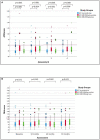Liver fibrosis progression in a cohort of young HIV and HIV/ HBV co-infected patients: A longitudinal study using non-invasive APRI and Fib-4 scores
- PMID: 35966860
- PMCID: PMC9372617
- DOI: 10.3389/fmed.2022.888050
Liver fibrosis progression in a cohort of young HIV and HIV/ HBV co-infected patients: A longitudinal study using non-invasive APRI and Fib-4 scores
Abstract
Background: The risk of liver fibrosis increases over time in HIV and HIV-HBV individuals even under antiretroviral treatment (ART), warranting a rigorous and periodic monitorization. Given the lower availability of transient elastography, we aimed to assess the longitudinal variation of two non-invasive liver fibrosis scores, APRI and Fib-4, in cases with HIV monoinfection, HIV-HBV co-infection and individuals with HBsAg-seroclearance.
Methods: We performed an observational retrospective study between 2013 and 2019 on 212 HIV patients including 111 individuals with HIV mono-infection, 62 individuals with HIV-HBV co-infection and positive HBsAg and 39 cases with HIV-HBV infection and HBsAg-loss. The groups were followed at 36, 48, and 60 months. Liver fibrosis was indicated by an APRI >0.5 or Fib-4≥1.45 score and advanced fibrosis by an APRI score >1.5 or Fib-4 >3.25. Logistic regression with generalized estimating equations (GEE) was used to assess the predictors for the presence of liver fibrosis over time.
Results: During a median follow-up of 58.5 months the prevalence of liver fibrosis in all patients increased with 0.5% reaching 11.3% using an APRI score and with 0.9% reaching 10.8% using the Fib-4 score. At the visit corresponding to 60 months the prevalence of liver fibrosis was higher in all HIV-HBV patients compared with individuals with HIV mono-infection, namely: 16.1% on APRI and 12.9% on the Fib-4 score in HIV-HBV/HBsAg-positive individuals, 12.8% on both APRI and Fib-4 scores in HIV-HBV/HBsAg-negative individuals vs. 8.1 and 9%, respectively in HIV mono-infection. The presence of liver fibrosis over the study period was independently associated with plasma HIV RNA, CD4+T cell counts, HIV-HBV co-infection (for APRI >0.5) and ART non-adherence (for Fib-4 >1.45). At the final visit, non-adherence to ART and CD4+T cell counts remained associated with liver fibrosis.
Conclusions: The study found a slow progression of APRI and Fib-4 scores over time in young PLWH with extensive ART. Liver fibrosis scores continued to increase in patients with HIV mono-infection yet remained lower than in HIV-HBV patients irrespective on the presence of HBsAg. The periodic follow-up using non-invasive scores on the long-term could help improve the surveillance in low-income settings and high scores should be followed by additional diagnostic methods.
Keywords: APRI score; Fib-4 score; HIV; HIV/HBV co-infection; antiretroviral therapy; liver fibrosis; longitudinal assessment; non-invasive score.
Copyright © 2022 Iacob, Luminos, Benea, Tudor, Olariu, Iacob and Ruta.
Conflict of interest statement
The authors declare that the research was conducted in the absence of any commercial or financial relationships that could be construed as a potential conflict of interest.
Figures


References
-
- Data Data Collection on Adverse Events of Anti-HIV drugs (D:A:D) Study Group S. Smith C, Sabin CA, Lundgren JD, Thiebaut R, Weber R, et al. . Factors associated with specific causes of death amongst HIV-positive individuals in the D:A:D Study. AIDS. (2010) 24:1537–48. 10.1097/QAD.0b013e32833a0918 - DOI - PubMed
-
- Stockdale AJ, Phillips RO, Beloukas A, Appiah LT, Chadwick D, Bhagani S, et al. . Liver fibrosis by transient elastography and virologic outcomes after introduction of tenofovir in lamivudine-experienced adults with HIV and Hepatitis B virus coinfection in Ghana. Clin Infect Dis. (2015) 61:883–91. 10.1093/cid/civ421 - DOI - PubMed
LinkOut - more resources
Full Text Sources
Research Materials

